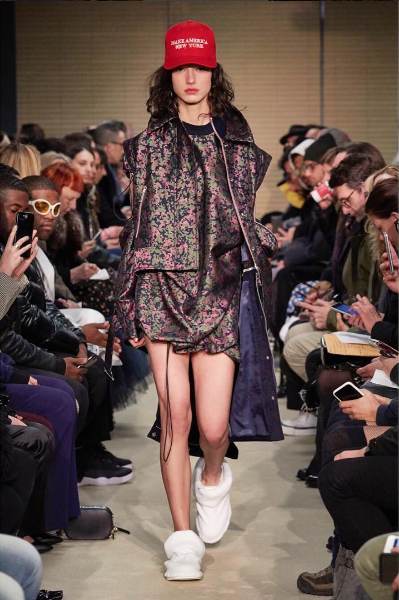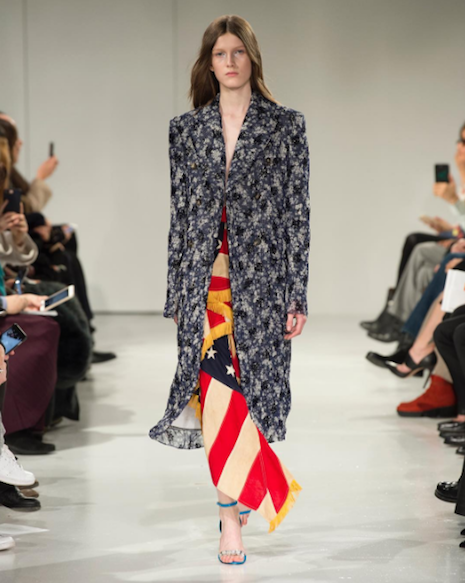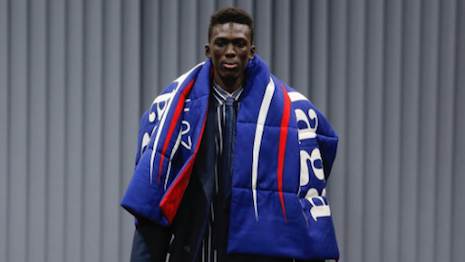With an increasingly divisive political climate, designers and the greater fashion community are using their public platforms to advocate their views.
During recent fashion weeks, there have been political messaging both subtle and direct, from runway looks that referenced the presidential campaign to statements targeting specific policies. While designers and fashion editors often inject their personal perspectives into their work, how will taking a side in politics impact these brands?
"While Planned Parenthood and immigration are political issues that have become heated with the recent U.S. election, they’re really long-term human rights issues at the core that politics have pushed into the spotlight," Simon Gerard, content director at Luxury Branded.
"First, [fashion is] an industry filled with both men and women of different cultures and nationalities, with many being immigrants themselves," he said. "This means the issues of women’s rights, immigration, sexism and xenophobia have had either had an emotional or a personal impact on most people in fashion, including many of their customers.
"Second, it’s an industry of artists who express themselves through their work. With important political and human rights issues like this being discussed heavily around the world, we can only expect artists of any kind to use their platform to speak their minds. In this case, it’s expressed through fashion design, events and editorials.
Taking a stand
During New York Fashion Week, Condé Nast’s W magazine gathered models, photographers, designers and stylists at Milk Studios to send a pro-immigration message. Combatting the administration’s refugee ban that is currently being rewritten, the video’s message is simply, “I am an immigrant.”
The brainchild of W’s creative director Edward Enninful, who was born in Ghana and raised in London, the video includes 81 participants such as designers Diane von Furstenberg and Joseph Altuzzara, photographers Inez van Lamsweerde and Vinoodh Matadin and model Adriana Lima. These personalities’ words are intercut with each other, creating a united message.
I Am an Immigrant: 81 Fashion Celebrities Stand Together | W Magazine
This video shows the inclusiveness of the industry as well as the sheer numbers of personalities who came to the United States from other nations to participate in fashion.
"When it comes to luxury fashion where the actual people involved are integral the brand, such as the designers and models being the face of them, we can expect the personal to mix with the brand," Mr. Gerard said.
"For large fashion organizations, these issues have always been around and something I’m sure they’ve touched on at various times, but due to the recent surge in conflict surrounding these issues, it seems to have motivated the industry as a whole," he said. "This makes the strong vocal stance that larger fashion organizations have on these issues not as surprising as it would have been in the past."
The Council of Fashion Designers of America took on another issue, with the launch of its “Fashion Stands With Planned Parenthood” campaign, aiming to prevent the defunding of the organization.
Pink pins designed by The Creative Group, Condé Nast, were given to designers, PR agencies, modeling agencies, influencers, press and other participants. Additionally, CFDA member Tracy Reese prompted designers to wear a pin on their final walk, accessorize at least one look with the pin and give the button to front row attendees.
These pins included an information card that covered ways to help protect Planned Parenthood.
“Civic responsibility is an important CFDA pillar,” said CFDA president Steven Kolb in a statement. “Defunding Planned Parenthood will impact millions of Americans.
“We will raise awareness and support this fashion week and show that Fashion Stands with Planned Parenthood.”
Individual labels have also made their position clearer through their collections.
Prabal Gurung turned Senate Majority Leader Mitch McConnell’s quote about fellow Senator Elizabeth Warren, “Nevertheless, she persisted,” into a t-shirt that walked down the runway as part of his finale celebrating feminism.
Balenciaga’s fall/winter 2017 runway show was feeling the Bern, with a nod to Bernie Sanders’ presidential campaign posters, with its brand name spelled out in red, white and blue.
Public School also repurposed campaign merchandise, sending models down the runway in red baseball caps with the slogan “Make America New York,” a reference to President Trump’s “Make America great again” hats. The collection, titled “You’re Welcome,” was underscored by an arrangement of “This Land is Your Land.”

Look from Public School's fall/winter 2017 runway show
Belgian-born Raf Simons also used music to make a point at his debut show for Calvin Klein, with the opening words of his show soundtrack a setting of David Bowie’s “This is not America.” The designer, who moved to New York for his new job, provided his take on Americana in the clothing, with looks including a dress that appeared to be fashioned out of a flag.

Look from Calvin Klein's fall/winter 2017 runway show
Mr. Simons was also one of the designers to take part in the #TiedTogether movement. Originating from Business of Fashion, the initiative saw the fashion community wearing white bandanas to promote unity.
“Designers are expressing empathy, joy, everybody is treating the current political climate in their own way,” said W’s Mr. Enninful in an article about its film on the magazine’s Web site. “There’s not one way to respond to today. There’s not one way you can celebrate or you can protest.”
Social cause
Political statements were also in fashion earlier this year as brands showed their support for those participating in the global Women’s March.
Whether labels were personally involved in the rally or mere sideline viewers, a number of those in the fashion community publicly aligned themselves with the Jan. 21 event that gathered millions to persuade the new U.S. administration to protect women’s rights. While taking a stand can bring brands closer to consumers with shared views, using marketing channels to broadcast politically tinged messages can be a turn off to some (see story).
"In a hyper-fragmented world, everyone is looking for new tribes," said Chris Ramey, president of Affluent Insights, Miami, FL. "It’s a dangerous precedent for marketers to confuse to confuse their values with their brand’s values.
"Luxury is about brand values and point of view. Infusing politics into brand values risks alienating half your clients," he said. "Taking a political stand rarely turns out well; there is little to gain and much to lose.
"Luxury marketers must manage every brand touchpoint. Having a voice doesn’t mean everyone wants to hear you sing."
Current events generate large, affluent and engaged audiences, presenting a prime marketing opportunity, according to a panel at Ipsos’ “Affluents, Influence & Media” presentation last August.
In research conducted July 8-22 relating to the then-upcoming Rio Olympic Games, the United Kingdom's recent Brexit referendum and the impending United States election, Ipsos determined that consumers that pay most attention to these issues are wealthier and more influential than other consumers. Live audiences and current events therefore offer brands an opportunity to adjust positioning and reach responsive audiences in volume (see story).
"I think despite what side of the stance media outlets will take when reporting on these fashion brands, it all will have either a positive or neutral impact on them in regards to their target audiences and buying customers," Mr. Gerard said.
"While these are emotional issues, these brands are still thinking clearly and they know their industry and their customers," he said. "They’ve purposefully decided that being vocal on their personal views on these political issues is something their industry and customers will embrace.
"Compared to the support seen from their industry and customers, I see these brands feeling no risk in alienating the audience who disagrees with them, as they’re not very likely to be current customers or people they are targeting."
{"ct":"So6j7i7VPB5rOH0FpMeUdELjydHkF6r2DlJMxYBYwYFa5jHHzXssqy1zGHGb7RUuTW\/cGLN0eSWBh0SqEQSZgpVdnulIWu+aaWkaTV8X9RZW4l9YfmHHMW\/7ARe5WvIMYEXlYQ5LQifEHOVth9Il\/i3\/64ZRPCYPylQBDQdh+GIFD7MSDYdq8TpHYR2IcDU0S3fdGi044\/UvBHnUfy0P3tUtz2A+cdQWuFOm5alz9PfEzzav74AYLEbHcd55yLFjkLE3\/QJFZPI2qLSgMNyFcTvUiIs\/roVl7HxrXCPijJb7ogq6a1eQW9jLqrjSQWI8PSRUl3kMWb7MjnftSclQy7qYXYh92nB98IwY7cTXM8ZTN4MNeusYwvcLu25R\/w\/heUkZxftwXgiuSGS5J3rMj824hHDqQPSoVUEZ8MK+pVd1Z6rANgrxpbmKVFYm4xVmo9WQWw9P4MFBipKzfVc5K830r\/zG7LUjaKfU9MyopWqY9wfQ0iwmXUA89SbxsIhurwbsrIq2cSdFN1ptf1X6sTucHc3rT4EamT6neodM5SKit2wz5D2gDYu35eieIA9ymhMyEjINBg4MV\/ki6MZsv4k+qz8KwqqHdtxVjsOCvP1UiCSLkNjNTx1r\/\/xnhfc8utzwe2o4z8Lq3OzFp5LpTij9YzNtWriOOJFrMm3ltIA14fzRoQNUkP6cYxuGfKDP9CKU5wbKNS9CTyLYf+M3LDrg5WbYayXHwDLHRX27YDPdCCXCOKBcVvnRIiMb\/3neEgluy4ll8Re6Ea19MUkuZ5w9n9SFwtqVLOeDh+XzcCip0cgmzMdqiNrc7DngLZ3wB0UXy2k8zdEJRRrr1WiqbPUZjcI0c0e27HlB8O1W46XAuOhiX9nOLXlq0jnHsoMzFkNYeMT9+8HrDUhKiq5HpnDsbC0Lsw4MtX+JPCEcRm\/zfHeR\/o1d9u82F4qmHkztwT02EdSl1j2sgcBcVyDraGyUQpHVg6akD5u+4zQF21FvM52mbPTgplwiXmoVdO1Qz3g9c3DLzkmDHAPsg+kyrjbWsheAzr1FPUeYthO4BfNax+EOHsPx3\/KO6OWzpLZJyGcUecpirV4ofdCKuEDu1ekR3Yql7YvAv20hIZl2NKbyiZE\/6pkD3LwoeGhLv9HOVkTZLx\/SkRla2vsqDLuvODVHoznUKaekb5UOQwvOn1AZC6xvSF1lOus40ilDU9rNYlTmD48i\/VdyEBFq8E9OvJe8tF8Tx9sB+EfTrjVqlHdEr76Ou83umuJ35V+g1mvxfLwH2AkArieS1QPVGerx54AeiKAvbsYRGIaOhlkPedTW2cCYIkL3+qv4LRJ4IA0SYPT8J49uDDcugGv7UZlHKtyOhwocXry9fcXw+wGcP1tpvK4w8HuQt0FUiaj5f\/Ik3PCGZUhRS5NAq1zgeG4FYBCjSZG600PZbMZsn7Jh9BmrAZpZYRKWtsrysot79FtMU8VT5yB4pM4a6Eo5glQztwux0CmPowa6cLb8qIY6\/Vf4XsBTtUwlCdMaetwfYhwm6E9dRncmF5ZTXakABtgh83LVS45Jrpmo\/QKdcaVNV1Db2Q7bqE8vRYe9ClHZFacA2EpsiGfRabRtryHO+chc7wsEh3giDjr+pvWGoHRDUoDodFOjMYoFF9Sqn91+XNBjLMLdwOeHeVa\/EMEQDdppVb9lgXSGypP9WTPZRBGqHYnsNxeOdNV8osfXR79Yx43ojoRbXlR1buYbvPRcFtqhjK3ya\/y29w7FwmfhM1nijyOFu9vKgOvMvK\/Y0\/3FYscUwre8M9tsWi+82pWWZNyS2gepLv2rK7bta7uQBCHFvV9+VmX\/Xai2S9R\/rjEXzN+jWO+tpWcBiF1gFx8VAyBu1vBWean6UEjfgvtp8D744oA6xrGlOJpSwfRPYVy53rJO2K3cT6Rx0AIk7aTT5OF6zuTZRBIIyqgxzyc0aSh+7gQwCNvyUEQ1usPhDJkId\/Dfx+XUWSozjjWhCcF5j3oJOXGCEs8ViQWaCjYrzcRis7cLhWu9Q6\/9n8r6splphjr2wDS1ZkyfbNdFkYHDgyBUd10mmdi0+JHwr1PlmtMBMp047G1mOM79GlyjUOgWd+o4G+3CzIcKcNVKns\/9Yi\/upYK+CV5Xp4ucZxS\/Z7d+Nj4513dCFj6MWwjmYak\/qFKk+4LHeknhFawdNaqs5eliq0lvKb\/odtnl6Pu664y10iw5bXb\/0PL1hFjHH0PulXzREoOGoshIKS778N5f9s+kjlgG+vKH1Od6SiS3OmbMAR\/8e0v3VmWk0QBnliRJXkoWx1db8g2jTN0VCJxvJLY2BMp0q\/5mI3mLg5ylP0wipxrXtV89IwHzEvNQKEA6aUeuij62c9tNiuPH2K4G4qzYSk1GSWZ2Q8GqpPNgYf+GGWA1lsBpgSqcngNyjRkUuJfXblCUn7kUJe9SdIjzVZyWQ90CPNcqrVQAqU46q2j1N+rjrBQvHKLW5LOidwRa0csmG0B1Q+\/85n6JeiMFETb5dRG0L1UbpG+hQ+h6wBv49QBqKtgffakzLa5HgtuBXR14zsGHmJUQgcbOLrVx6uQOruUq4Y9JcRmPZyoX8i31hVubj4KdSxjYFXMT9x9u+KRyu1tluCOih07Ea4J0vtcVzOn6E8jbTkuOnaDmwpocfHY3N0UiubfeVxQIXBL3LUEEz0FIyUElqsVN5eHPUruMojF9I9MKii5kFhsG3+fy6\/P594zKXgz\/5Gwr1ytyJ\/dCv1fDivuqd4TivosVIa7pzNePYGY6adWSrTgxWPFdgCa3uw0D66EwVznUu2E7AJRlZB19Mx7+YzA4sDzQ5AX0WD1sWay\/SChcyMcoXkkLzgrjogXwY4XiltwZ2EdNC0Pj0zGz0LC2miXdNEMSAIY1h6Toql9g47wv9Ao8zbD28YjHCqdou6xFvFa6e9RKQAHMeB0CQ6jv0Hf6MwC7nIIe5VaGHuid\/d8EIi8mako1afpNI6ZWcK0wPlcX\/Mp0l4I9HvU73PIlWB12YWPvaPR3xPEARpcM4a7GUEcauIL7Ef8C6gKqPxNF3HableUx2+wX+tZrDkFa84NrvOqhriszRX3BkFycUb\/cozPgymxeTJaYK4WryEqeLVf86afC0aX92y6sdliCD34yG16TneUwPC0hnCvpB\/Bol5zVDuJjkt4wcutjeeewEeDtUuaYAnjMMazLGlmdyk1VT06rL\/RaKZWTbk+ntM2ag+9g4aKX5uhvcMQk86VG0m7GVtUaVLbituaXSCkKn2reJ6lhdzUhCppsGaQitlYCNRVUGWGK22f2vZafDEREtzbB8D7Ho2Tjq2Jnc6twXqG+IYHXKMsaYmVfMes4Comk0eCJLp0d7qsjw0WuFHIMh95s+jJ7K\/pdLEidWbM97MlT224dZ7QwdfjvTz5m2Z9OIt3jsplQcdMX\/nnpFIZiyNAjWnIwrSmiQ5sEJfUcb2HHZ7o+qmidnhU9FQ98jkQZQDT7QeuMeTZCN6qa9xIkFpoZlkTMT3XbHRtr7CO5G\/MeAub1DlkvmeO7b2KXqpXUODJN3DgfJANiUUgzbXAG7zkAz+Quod\/C4s1YcEfVyJV8UXHbMqeQg+z\/odea18yuO31rKzxFQLt6r5jxqILFyPqRDCNqhXZhRYH+qb0I1OmgXdNumXx1Og\/6HBV2v\/XTSuAYb6kAGWRc1fdC4oflhc+NxToGLMmp5F1Hzq+Riu3U3sfgj46f9UzXE+f2Vce9lNX33OhnEAUXaDKt\/ycX+aBDhqftfuDp7QpJmnblcZT0T+YotV1AuWP75Dpv4jvx286J5MiIx52SY8afCD+1\/L5BZ6NU2If4ifplxXALZ3Ixv6aphG1tGQ9BIKMynr52g7v7MnvIMlBKJB8KE\/NwM7G\/R5rdrj4HoldkA8rz5YrA0CX1NtpTaQIxUjkamkbqqKL9ayzv5xLg9mNpvad\/pOqDORzznQIEstKmT\/bZpA2eVVn6cQhnaYyO4u0cf9C+pRGODb7f+DAv1gHOgsF+41D4Eo4U0mxvlQ5vFrQ80viwmSba+UypQcBch58EfusX0qnB8hMo2gYOkGZkaFi6EJfXZrAjqL07K\/rXo++qOjh4JTi9Qe6QANmqcMg\/YbpJOiAjWtZR4j13OLaehSNuWk0pvkMqpZJtKUB6JXdb1mefW+\/BVVxQ9tQuLfT9jOElX7pbXJxHoCBEsy4uvvY9KR+3Cfe+xO6NNZKU2duSvPzZ0GH5B+wUoodFR45c44a3Qy04lGUqP35pB7VywBtS\/nbqDImxvDwqxjFXhgUfZX2a6477m7yJ6U3SEgNMx0E5UOQWJh7fDDePEpc83rualeeSWYW0GDagGQtqy8nMA8+xI+rPS\/ixL9hyFkZiPjSr8rUQryDDrStaV03X4OUpwatWDPtgYECn7C+wL3rGTcRwVRyy0Y2uxduK9hZ2YHUaTC5NyyiEL8cH\/aY9q4t5JqfE0MtypTdUnSnQbUZKhBGOD+mQTO7uk\/D6DLYlLeRHl5+N8Xtlk7XkxfXrX6UewOXnQjg2wniiBmKyFCUJA4PSbVqAUMxhl5V6UAIp0D33hYnmNMgZ43N6wiVjFC9QZsJjwP15fPD8vE9ouFU97b+rMYpZ1XWffTPoGZkgfkGNmfJj2sTJfIr1CxNtWUSxAh0INLR3AszgVNaJ89HTjdXNQ2fF+VwyhFzhnvVs+a87bEbitXsBSpSJMWl2j2OegZb0ys7czvakuYkJtHGgSwELQZ55XoJoM6ng9UfV1gVprGbcHk4HfbsKfO7tuRI0BaCrtHDkuZu6avRjO+FpbthvhPKDo1UdSE2Qi11yLdoGnWk8BZYK6HV4BATWhIXgkfTsHOftZ3C31qGc4PV9HZ7S+R0xc5HgJkUkaiWxZLhTyOH2QdaVXjh11rLfHnfkFxs5I6od2WiDVLXl++WCJ9i5iWGWsqKuUVLeZ8MggYiYy\/3QJDsWI\/jVxL1AvNQp6YH4p4q5+TUdFE6bO6EuBKBLo7zcnTxT6\/rCaDhSoP5djOdx0GJvbC2Z6Ji9jbkd7yQZEbpyEsQi1dgHZEbaf9oF2H6SeWey60wOlXvmYAwDpmFhZpKL+tGAhfMqXmE2wXAJ6N0QcJ7ZRRD4fMXlXlAJCRwebchA8hQH+omKFu5bCj2LsithLNp5NEMEBRHBfPNMX+r1yUihk1bkjHFLoVSxdQ8CdtKoVmabz38BEAc7SSL0+0kM7k0A0+WA\/UU4JOMVYqSDqgDxY8pwa49pBTX2yipU+mJgMmd7cDDVrGFAPfr4\/YqAKVMDjxQjRM5IOy12ugG7HICcj0hEulf74obqfx+5wKHJbHd4+rJJRmZwmlDekPvsw+ZZufMulj4tI4fcuwwtd1ETkmjAsS37p0qhml58WrAJvu68XKjgyQpl+UGZwg0b+HRGLPvrgruZ8qmmCzyGM958E1Xa9vWirpdLfXPpIc9FzGsRFOJJtqw2d8bCVBJGm80B8Q6q2zWumu+PHcR9X+LdH9dM67ECpa4Kvm\/aJwmgzbh+2dpKbhn8vDoxOBMfqY\/oYXh\/reJMG5w9uSjcPVPAtYNX8sHwCkV5ablgR++jBvS3gDWt7KOb2TRsJq80x1wtHFJ60hTeX19c\/leSIMSS30NpOQvpBGkPy9G7DHL\/+9\/9E9BldIIpQuXumSFiGHi6rQhrr0LWCoOhEPWJcrGHkP83+aOSpGc+fv\/+LmSzVGpmXRt+U8O0Gtknucqn11CkWVCCirwiTkv3SAwIJCc2GLS+feGN0sowyShrIe+a3si8kp8d4eMEbXOp+HseSDguIvJuOzQn3kwNC2GJa27yGlTbDVyEaTfjsl5NTgfNCNuMbcP6OZqF85i\/A5\/f6WywMMolM7M+sp8uTljU+yyRKfrVvSiJhIJuC2acjaHghAc74ieKIH58o33b+6ds3HzYnF83vZechuZJ52y\/\/KDa06\/phlJGisnIK+r49PHsBQVsUzaQq\/MONU1t1OmeYKJuil33taJYr7Mkv9+HhLdr6aLthQ7Sg7iXGqxpHpl+moujpCH6FZscesf16jBE0d4yRm6xdAZHx3M9QL6IIRFmcoCExYWFR1mIYa2rtWscpsqqnd+V9kMfUoxSjZ6fcRa17N+4aAjt48Liy9Mu5nJFrDmI1BoYxd8rHH72\/YWV7W4Q13\/dn\/ZTELO3+dEUcrH7TuRYo2JjzMkJ2XNkI0WfMVWwDQpfMxobGEa9xwlsezve1hTO8TIzn3Gan1O8UHEcoEIuB+6lyxov4TLlRHKUshMo2NrZto2YKLHKyN+HN\/Vyp3OvZkFoMNqhwoRNUwO7wBVbO\/I\/QmeRQV+ZXTsF63PUWAtkXHKR\/JDy5ETrXii0m0dwdbVOYl24jZXspRKOUCMQjLm5wHnSFRCg5X2vb3jqdk\/1+D4ItVFnt7fnSF3b+WNNt0\/7NjX3nGliktY2zDtghqn9+dddYuZJ6nfGUMZQ9czGoNCEQuAWjFeuERvkI7pAlraBI3GhG6RbVPyFuqNRZE2\/lgC2Nu8S3E9C+u8Wyqm1dHxuN4R+ogkqVAgCyE99enM5brHWfN\/ziYlMb5nIXttskVAsbupYiQgHx3pvoPOQb\/cjhPq5W3ouLcVflgBoon69g8Gf4oVo5DIgOmW8cxIN\/jY3XQuucHUYusIdpthGB8pjK2LkRix4KhUMeP0RJ2uMrOdbdAbndHs5F46DpmFhB8ciPDV0J9IpQLIEcaMvzPgaztr8shDxr5mb6ESsPivzGHs2FfqZBoSIbbemqphYncU\/CqYwtkC2+ePjD3eaEmMn6v05KkRcHRF3uS5QmaL+giWVKhm8VE3yhIsvrkTbX678a5YO5PDlXh+p4wivqsvIZQsRpYWVoF8+OJW\/CastZfhdtPwc3FORCmfYYv5mMEC1m9pUJWH2w3c1e8\/m5MWgvAxCW\/O5eubKWVwZVBpYuNlr0a7cwIveeUWrcckyLzEw9kjeab5E6iHFAaq1z+f2glLFIj+gPdHQagtzWAo36NynV3NsTOkRyTfs8F8q3LMKTDWCyl+w8tMthWzPQ+e8tQWjHxjt7MHaLq0uq53U6TeyIUQB8DOZRIs9K0arOetTU7+GzMu7WUpuk5\/9EHWYREKmMsjeV2MxjBOIrXUlyRpaSoGCLxjhE7Q10xQ4nmUb8VrXtD5eiunGZUSTACW7QoqgBoxJcqeivvkDNZZ6UIBBs2fOu1VI9RhzBMcCs6490g9J4AKS9adMKaQHm1dWOUvRQ2h8tBGhlCT27BlGYUJch23SfiiVAVBWoeDbYx+ITgMc4fBFMsuxq30VnvfKsGDdNMSusRf5bHeZO+n4E0\/aFTPi9KRYYl9fV26QwrJnb\/sAYiBQCIgDcmFMrCDUwFi\/Et\/tQgEGw8CkSdQj31Bq40LrZpYOpBhGyNX2g8QS7z2UidpNhznJ1yI7T0ND41XOARO3duJB2T\/nNJbMne3yWT7GFrbU9YvC0RUO+OHIEl+D4tLXhAoxYOEkFYGwAdjRQF+1yK\/LWBdAKsVA\/hAAb1P2M+rrmR40tQJuEqTCTIC1ev4CTpWVFkEa+dqtj6gf\/d89FDbKm0KPtzMe1w2DcB1nU1MWowNt7Wx62KRj0phfn4gWECRFcuz9h1+oY5z8fcBYwr9SsLGkwrN+cNzXdYSJagb7nGU0vC0bVQjDFmPyQpxZHPlzuTS3cSnQ9vgm5M56mBSrTptIfvkoGHSvcXK2\/8cgn1RTCPVIwQlYt9uqWh\/kRTr2Zyc1RuDOlsJMAwgKhE+b8zepHNubnG347df\/nozz9Delx2f3vC2l8drWH+5Pt0Uno\/fIeNSPfzaA85pP52HoDtz0JPF36FHZqBzhZfHgTZuJBxIN6yIGLsC0KMoYd\/f29EV0+yJqRvP9vS4XDbMM6\/3E3SiU26oIuVYKHm9jvgAZh7R4vmpBDdwAeTpa1otUVkI\/ffbz1e7wM1JSZJjkwv1ed49UoCelDz3Lgqqo606Nmg4FEP8DnHwTZq3rC4OYI8n\/lIPDuzwvS9oNcGE1mhK\/DCLHMTVhdSwKHuXLKtDVqUmTj4k83RW5ZtlAYoEwlBBbcEMcyfR6bmW8JIfZ\/6u4tEpWlsLACxBsroRkwOP4KLzIeaj8WCX9Hs\/7JiGQJTzrvVlhKNJsvzx29RVb+sUgy2gpBTc7gELm5FdSekiAZnORDQSVzBLPbY2wsGgytPNfyiHfUjhG\/8T8a1G01TTa2JWvBneW2x4PiKU+mZuPeGuNb3mQuXWsWronw6LFu1ttZoAyetlxQ8HZ4w98RJ81sXmsPwTODV4+EvkbyNYUIpOgc82SX3DBZ0esGFhjxFQUZhEn4iGEaMmxIUqenj4F\/e0R8vNnzjZHbioHHrBfkVog5PM1hEbTI66Cy0fW4q7FvqaCNzWcFIuTm7yseQw5jhNfox\/31SUeC6Wr6\/VkGRCPHnCXONwwmlZnxVIDHGmzxWwsSo+rd+gLWpm\/cCT5NmHFCeCM7y70Zdmj6bVkiPjVQZIQoCfD\/IeG7BhZcy\/0ZpmspuTYF59ly1lk0hiOUvOktIpd\/g3EDnmXawmL7xwXu0rlsFr1A6wfrR+u9jQRaVcKRatvtfDwergNXYbLAz8ybxl6ASct5Dgj0iw3yM5ZyPbhkxjC4QMvPBjJikE3l38x\/vHL3PfD4cnJsClP\/f0gEfE6oDn+hRJ\/\/Cyu4JTi7ROczPuabU12dU34lG1JlpcwEjR7u1IhQ9Zx9qiKx6zoTSy8LN2rGH7t5kHcvczqK4EkUXQ0KEagKMqbFTlHw29gW6TpirlXVDpgXtzYzOEzkISJKc83Pant1q\/2Hn90zv\/fuFchHBpk2fV8ihFnlFlWjQfqem62ewGvUq+I7EZr3DMKynb\/O9n6yQ3BBY9sBlLKlINJVbi5veU9dbTuTLBVMfTBgkK9PxvCxMquIPtQ26dMKmoqOGOjRzVUjACx5D+kTHUJPxLRuOzS9wJfZg26tIgbiMphYawUhNXGqltfJWnS9HGhh6d17qUaEWJ0NouBqLyzN7QYBfi7xnkZam7joO6NR9NFV0ofFfMAgxPUc+ztL9zLJJg649l4BXaJcaDddVJbNozdb3GlJc3NBkQ4eni9lWl074lsS25GNV9e1i4lc3R7RGxLolGymhG4itNWLTIl0a0zvAKN9rGFpLCj9xfTclnuJz\/bCPRuU5XcXSQCl5ywnkYq0vcLRmmtllg+oETINn45qXOFY6xC4GgMUIeeFTrdjHzVwlNkCM9G5IPiAhAsjCLALbs7BQSO2rSeOw+G+j3NMCZwBjgrqfGjy2GTDGeK2Tj6g8Q3ObRE7n5MNytIkoVyR5GvWvTfE\/UNomdH9nJfdfrBVIVrs7GSiJ7AjfznbN2KsEhwmFmObxRPB87ukO4XdgnUZNgwnc21v\/ZBAuuR9RvJU8m3w9vJNPsqOBiRw1LLiSYdtjO0stP4vcqL6mH2stZfuqaQaGYtYYmNvtWx8owzj90IFh3xuMPJX8FQKpJt9mEOdnKWdGPZAu+fTrvYkaRjDEJ0OPNNm49De5Mu6cbAb\/jWbqcFF365OX80sg01c1JkDVL1ZwXQsMJa+Cxip2LY8x6Cz4gsFZsXyycpE5sFbyn7Cf2EKrJPYXdxzrQ2OALEV5gkOGWShEdhDbimqiSKBrszV0+rbp9qimI9c94HS3HY+Fdhsv4\/tyshJlSjzbuyERGEYQ4\/DddWQ61Lq3+U+AtRhFnS0Oq\/LUrdKvzgP9AuBF6ZYGsA6T3vdiTwaBL49qZPansT2MN8QZaAW0aqeKBTaoEDMAhErjLR5acH4oBKpArYrvRQbSjpYkPZOiqsLPxzON4Wp7Ha06jJcWwLTMu9esUKeOy3Q7xKwPzVQ3TAbxPbl7+4BqkBYCUmY9\/SprAsp+6rT+pn1UbIe3AyTntvttOrmyRpMiqwn+GpwvggRTiAq0p74+ZCsBWV3INEUXzTBUx83ZwPz6O6LxDKQJYcNia6IDoH6\/qN88X2K4F+sfG5wq0BZXkAbMRIf6dl3ZsVlH\/zIs7\/W\/WnzBj0bzo4Xjwj3vJ4zkM90wNxhTbyOhu51AucW0lxkSRhJul0nITCZYGmxZiduxxWcT2yH6SRU\/J\/H\/w72kahImoIq5uG\/Sg9kQp\/gV4a2K9FNJ1hU0NowHZO7oDLsqYOJ8NpIZKxTIQ1gERsw6tNA\/ARr82ZWmyNclTRiFpY67rSKFtBCV3\/+\/cS4LSJVpPAyniWBzqU7gvrYfHOgPFBOgoqrraDrQk\/OEuR9kM\/yOrtOZ75b7deZqashIAP5HNwUfScWwB3sPhzSlJDDHcZaHrG7QnQdWkoYcPh0DoU3\/or0d0JSRh9qH3jodidStC+\/OV3\/D7Gv1tyUHaYKNF7FIe0\/AEPmnjpUpobinj19UTSnabOSwcezc9uT6cQvIfur95iqlOqH87vgTP5CKXZwpWKaNgnAK3MM+taHozUWpBymweQ9vdUZHUxeZ8yS\/QUWOZjjnYfpUds0dPRGptqAOgTVbCF8eKn7nt6pb5jxWT48ivDpDiLAnHAAV5mm3MUlFiArZNnYTz9YDXQp\/VWFPCJ8WiVhAnpg5xwiatbAJkaFS7NlJ85MgNMJPu9jHNslbnImMLLskG+pYcL680eBfCbTokUMz12rscDxu64WMAWaez\/ZKhmLW8D6hyarF1\/0zFthr2HvvrHyegpVZHfqPVtqUSXDbR09wLzQS4YMsLERx\/ltPv811tnjehm8E2e9h7PTP5Dbay0jti8OhN+a6IhKX\/dKo\/2zsd1c1H4nujGyvK\/eccrg9S6qHp6AJ+j0ujTmZLuyelY3m6hu1PHzhp5ijE9Way0ngASuJObn5+aGEaSGj20zqE1sAc\/0FGZbLMmPL19zHTaZ0G6X\/8Giso1JzOljRCoZa24aexyLUt3nii81HQxRAhaWFKh1RlcoL96PeQhlXj+ZDPlCnwj0Jh4CfJCzQMp1d3OQrdDsWIC5n5mt\/lObjUtuTVsf9a7ibwpwN83Vb5FlTX3POppMi9ry5EN5osldWuciz1WoIpunNJsnLeAlioLeNcHmZlkbwSDqFof6pOEUctZMUrCzzlE6m3aVnzdeBhgoloqsUxWNHolUVwsGjyqWsbWreg2gFxFarEwcNz\/ol2B8IqlsonySuOiIR2Bc5lxbEOxMTSbq2vZgzSKmJFwenXQHG+YolVVEUsAZgMgAd\/OgCjWUAshteH0\/Xe0u\/QjTrlGglme0ITy\/FW7QXyZlscNyZeri0YjBDdCS1JSDOsfLTrxf+rUq0fn96j4nNNE2wsfPDH2Q3kqGSIULicth2enSQzEc14Raw1nQCGIr3gKh1RK5oWtil5y5svZ4VKTC9pF7TrYH1YqbkoLMAMc3c9+YznLo19jwZMtcO6fsH2h8e\/RWe9VTjza9dW2Tzq4RbnLhP\/k59x+D1Gp3UDgF1cLlXlIio5zVurmKYGKOG5pIJeNjTXYA9gQuatuAjlq4Qm7OS3cY9yMLpclTGwsxusFadtG\/eQfs0Dr9LHgkGSCMXJKpeNMI5pn3jJSoM2J0jDToVmNZ0c52cApDLx\/DAalFEaQhRQ7A\/lLlcLrtIkIfDHMuGMUI6IYYxtI\/oXHZ\/ps69iwVaiJcmtb6CGJezz4BYfJgj6lXTuufbFdQZ6F+qdeoPOqOudazo4RkYr7Aj\/fSELAz28HQLslQ56C3\/fNg+dVZDl2TiROZ8dBiuiiBTm0WaHhFSN3KZbCQuZOykubwGLX9vEQua1ofWh\/wR70i+K\/\/FVNtPFpJGdFpzGC2\/7eHfTTlxhNjOoCdp5PZncLRdvbJt5mFHx3wE5rYDzvNbL\/aDC6CZqwM0l5pokwOyPdMrWUwakKV57Z1fsguFcO1PjEWD5o2FSj3tRzf4Kq4G\/zDiu1erL256UXHPOLcRL0LNSEZnq7gE3lzeuNATairEp+r1BnD8e9URnJVm1Cy3iLRAjt+f8BlfgJcoUgGYM075TXGL7xHK6qPK8bnpMobCS0WQ6DcpSgKSuWxWbFdxTbG8+DPaJOTURP4NFuGWAAkhc4wgzNiBxkn+tdovdnPAepT0mWBizlfbHg9CT1Z\/xVlwBsNJm1i4E3y2ZeuUbE2gyKLO3HerUUCyO7W8mSiiSk+tHkdaA6FFqlvUtKTX\/TRynIRto3hu6QcqWU1CwiOSCaxersQ6cl60P1o9aNAQ4lQ\/xvQ\/Y2PIT1jQVgfnQXsmxzx4VTUKcYVjfAeFThTQ2BymQ2PySlLLbR7dVLDysZedgQmSxe81EzUeHSGMN72jBRlZprCT75Nv6PUGHh2njAkfT7XuFgFobyO5OgIArMCcdWozMm2CrO8UHuON8hw3t7RlgXhXujTg3l+KurBnqCUJuLpPW0eiSo25C4M+HAtGGKhQg7S9Ri1OqJBVcIZn5vK2PhQYRjbuyxHx674\/XUEEbUsucwm2OdC3uAb9TXiL4FkutFClrOTCGdsZVl3jbIhVcmQX87XzAmmczW\/yC8cyEupbEKqpSv+u\/ax3U8x+rlPmwNbJ3x+iqwZPB+c1+U67KImlioJPv6oP7JJaQxRkugJdh+u5iLF4zgKDx04CFHZBD+86hyOCgG4f1yapBpfWsW0cBAAjOwdug5fQ9lqQzcEo38jnkF4kf7NTpJ1gkHTBfY5DkWUqf84Ap7ThLyShZOPo1aThcD7zLTHmYLeBff3mOQenhVxxJW4Od9Lk6OBPrlCEDBgVI5gndNeGRjHtHn+aynZc\/KRznAPOy7n+u3p3oQfdFskFksCBosxoDVxCvY8e1yZCTibQp\/\/cd01ipSHqyKW3CqOkAYq+fR8ObITfzn8P0BP2e7OKsBKUNtbPU+eZKCV1UkaN+BsjoIriySdpJ0B8TlvT8q+OD928b6jdQ30LdPmMpSxHL0S7dO8NePjaQSniVlC\/0ZkR2K6j0oHdMzol4eKGYME0rxK6Qkpv6\/CSYVBSP1SLKl0u1cYtVfGRjBI5ZfTQv8U2pVBkv2AMiEmAPNa4F4jou9FIov5UgWxdzt5R\/ebMZNUiTx7dAjI0H5E1zKrGcVg04nej2RakrzH+DvIdl+J0Za2fal5+9cSfWv88PX6IPm8R0mKvqJ1yurz51Fg0hP4hmM3Fu\/wUyip\/ySWt9o0CO7J8ol1hUK8Q8YDUe+jDngzkPnGl6aKgKu7puvJfjOhOAQ4BmLtXroGSXwmbJ6v4GB8Tbx5aippUpfnJwGAJn2BFFb3Od5f84\/OyBDkelbxIzGhbZZe6C6NfnD8RjN9cevD9uK1qLFr2EN2Fpg51Ew8VOrA9QyhhlhQ4lZGmZlyAbH\/I9S+st\/QINzLjG4H21LivPowFNm\/9E5g4FnaR1C0nZ+wAL4VwCD\/ECrYOSVr\/eZcWENDE5w5jKEF4KfwTpmjrAeLhsLJmXa4V9BYx98906TCSgoFtG36OD6QqJwazYTZM1S8JrOH9oGmGa3wy7ao7JW1p\/6BbnLGcIa7XaLMY8GgueXuLa78ofjQiXIAaxsS+nbIDp6xkLCMnMVlZf6TGR4U0+lSgeBFKwWbin2oEnvivIaFOr2j7lWc102JNYmtKErEp7+12\/pKT+njT9ptkmANXj7WRo9QZfadI5PcCB2T0lmPjqEJzdHkhFPTICEN5URbIuZMum5z+Oywd4vdHBug8jDEc9j98tfyP1DQQUnJNhkFdxTt+7SYyiMhhQxk1dk8v9yDBlJPx7N7D9OFgmUZwuz8EMNp5zw2dwmL9q2FKYN2MIvDqTdGX0g2cUMs7MBEINVSWXRJ\/0lEUCE9NoeFAXlaR038KMNdGAqrv9Dg\/rvugoF2ktMMtoxsBBle1A9FB7z7PjIYitE6b5Z96NMjFIawd7kaQ8L72NO4SLUZv1JzJbzfn3NVWVyNFvUL77hO+49vRlGZklLPSsSVqCXqDdfQbxkNNoTNEPXVM4Vnp5JsMzmZxUG+Gd2EqMTF\/HKSk6H5+su1ZM6KRijVauF2yu\/L+B1qwKdO7lIEOtXs7vQT3s3pzRSIJhcqnra7TTmbtoQC6p7jhNpbYMtvIgkrEj7wDlXoZRIxW0PVPMuREO1hpddkBmnxwB8xKhGJFb6\/nTfg6+Xjd7M3kP8jRRgYQBYCelhCTvKmApH5KLcYAADUP3wfb9DJPRR+q7g4yfMr4I33eA1JwAWwwxkQOc59k3gyFUpIBtCvngrGOI9sMkhwFrco2iMvpaNrDEW\/A3iF62oIPF8rka7uGzy2tAJLi64bwfnNZnWkUpaKgS6goxVSLU0l4lqnXFWvI888T5unIAk6pn8BIif4DT3Jzu0rJDtci\/T61qHU3dS0M5tEalT7twqw0K0TEcYlsTHruBfppoWBaZ5bpgdSizkv\/XPRWvuvEcV1A2afzaVixqDU4fTjegaYFT9wpim6\/EJ3efE+8\/rmUxu9V+rIkAsivTkbBuYKv6JJ5RbFIcrj2pcA5sxVjVZ1RGWDobtWq5cDDLXwbYHwCzPLtAhJdDMLFnkoBWOc4vdcSzLz+DhoE7TgiX9xc82XMtvQ7oJFlLWs0zOIQffG6hABxr3weq9b8g80W10XGtxPy726Pg4A7TTvHLjEgmqgz2Uv4x2kSYQJEZSbViVeTwXtCYT8EbBEuigeUeSknd\/WQilJzuVY8VD+qNYi2J60Q5sfP2bml\/gBpL9onGI1\/yhqVwANmSPlChp\/XOLcmr5x0yuaHgHidT8AzxoVJReelOfJCVvapqGl4Izk4GhitHPavsuq87NFXBV8hZHgpPdwSyABb6vixBOTXQ8e6dHD6XpCt52FjpHGrJjGYdxaVPdi7+92FiY8ToCw3mdKE\/a5iYY9lU3BzrNI5T0vJKKTPEBE4fkX\/XB6fJiagne\/epbxv3QBDUAMfTCj8JTUUow3VvFRPB2zNN5mFFZsJ3SlSUiUqgOqlF9zzyCrsIL9xCRkraIlV5Hi9BBtu5nycxlk1pALCtnaihTi7gia4JZSKsCjqpHI6fUL3Wv+TyidzHNQDKmIOqLORIo2+FgztwNst979NK0Jm0skuBqOH\/BMy8hUk040BDhPXTPGTPN7J3jVoxVprkIMSw3t2ydangaIJvggoP6JbHvE7AVXD8vxlZk4ujOoBvk8XeWLBQT8utQjqjwoow6BOOeR7gfpUhuVlMMNiir5p0Vv9Y8M1E3iS4IR1AF7m5HYRk5C+0fLAPkvsH6FR+3Xp7YlmqMofi0j\/dsmZ+nNxW8MmttPxRd3xZ7V\/R8foJBFp2gTNeAXhmxOWSF97K7sgibAKzad1tRZBGdpLYd84cGhGslAb9bZDUB2b7E1suxp8OSgucS\/XKpKxmqeD47fEgbdu8RglZ7QyWiKrU8guQWnu4KvG2gwFYy8DGDzdBZyX5PYO\/QgicOc95pO4IDLJ6EKXNQKRVgZbfhy0H0oI9Sh+HhQ8UlD2J9Y++44M+VaJZzAnbN6fxK0JWiE2Ftf4OVd6ohlNATQidC51u3whzIA7fcqrpHRfwe48OyrHqbllCfHU3fV5dGSJl68SiAq5NHgqc9p84xvmVIZkU7zH7iVWx8qe7ecdDXrmp9pwWhgOSi1nFg0dvPIyJhn6YO59U\/bbM3x0BdGYLRFaBNhKVhQAJl\/Y5RD3mZxDjMdaid8VjIlR7TA\/bvJB\/5jkp9Q5gcE6gk3d2peNWWZGIiOdp2bUTFLFCR3o\/2WuA85grzgfuQkwnEhbEXrHIZcSQTZYUIWLWuJLO7ZG5AaqvvOq0fM4b0fwh8wi3g47Z\/1isSiqUf9oC2Kf92i9V2jyYPcEcxIAgc2uaOzBBF\/az9mD2P0N1WGtauWCCHtkAbzWHWOLhKoGN8I07X75PumXfFgRPsXLy4+QXnhTFAR8qRfGdmk98DWFzlTyr4ky3r7rCiKOFgwwv6mAPvrPwGZ5bxkZbjX6hOpFD0Hqeo51STfy9dC+MT4+Y1FOPVmrpyhzVnY2V+VB+IE0czfUZvbu2Uel9tkUhTu1KA5eIAPAmi+fcRB1U5m6Dpv3VcS4gdgBUsPFaqNyQ95CjiwyaAhiGAX6a+5wu4RcZttjfn9nBT10aOfGWGO7dL\/toisNwF0DgcOnZASDmbdKE13avZpXNTOyrFxdfXGBDGwwH86oLi1DlueVNnbF9i4EezlZBCFUHP0kVAw3w2g84fAsNtf2b256Zd\/cTtcSRYsP71v5No761UBq6e4v2nYM8VBBWzaAqvXxKLJMXDeMrnKu8UYu52bzJEjjUy97Ix+jIkErsYGJtBQmP+jeleqkzIzVkNX1p1zCxgv5L0\/bY7aFgHXuoMZ4ccMWkuJ01mRNgH5wpbiilqVZyZpnEIvBBKRO43LGLbD5yqx\/yCngxQWp67A3t9C6RgJZxwfjsg6vBrHPMNZlu4\/mXNWGfAqwdkeyKWxmYK6pznPUs2VPHAKA19L3J69CCwgG8mHbyNJMz\/B729TAfCUcEX+q9UoCqYZ3oGueD7sStfcnyRHQgujSlvqZ4Jk5tQc7Z99ythEblTbTReZcEimlnAj\/Z3Fru7iSkUpY0eNM6GKsrW3GPeNsFa","iv":"52ef9f19a8063ad19052d852f6248f07","s":"f49178b451cc8f75"}

 Look from Balenciaga's fall/winter 2017 menswear show
Look from Balenciaga's fall/winter 2017 menswear show